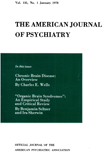beta-Endorphin and naloxone in psychiatric patients: clinical and biological effects
Abstract
The authors conducted single- and double-blind studies of the responses of 7 chronic male schizophrenic patients to 10 mg of naloxone. BPRS ratings were made before and 6 hours after the injection; ACTH blood levels were determined before and 1 1/2 and 6 hours after injection. Statistically significant improvement of psychotic behavior occurred after 6 hours. The greatest improvement occurred in the patient who showed the most pronounced diurnal variation of ACTH levels, and there was no improvement in the patient who had no diurnal changes. Prolactin plasma levels following endorphin injections were apparently dose- dependent and peaked at approximately 30 minutes. The mean half-life of elimination of exogenous beta-endorphin was between 12 and 35 minutes. The authors theorize that positive and negative behavioral responses to naloxone depend--as possibly do many placebo responses in general--on the relative stress produced by experimental or therapeutic interventions.
Access content
To read the fulltext, please use one of the options below to sign in or purchase access.- Personal login
- Institutional Login
- Sign in via OpenAthens
- Register for access
-
Please login/register if you wish to pair your device and check access availability.
Not a subscriber?
PsychiatryOnline subscription options offer access to the DSM-5 library, books, journals, CME, and patient resources. This all-in-one virtual library provides psychiatrists and mental health professionals with key resources for diagnosis, treatment, research, and professional development.
Need more help? PsychiatryOnline Customer Service may be reached by emailing [email protected] or by calling 800-368-5777 (in the U.S.) or 703-907-7322 (outside the U.S.).



